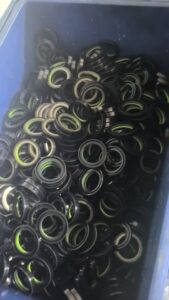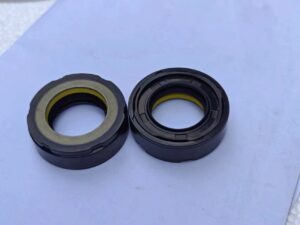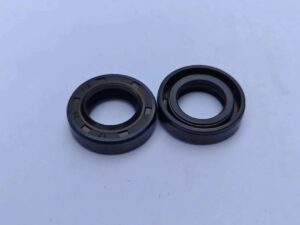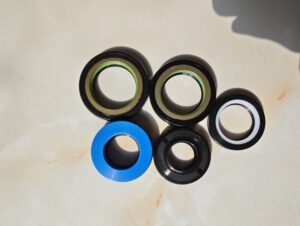Table of Contents
ToggleWhat is a Power Steering Seal?
A power steering seal is a critical hydraulic sealing component designed to retain power steering fluid, maintain system pressure, and prevent contaminants from entering the steering mechanism. These seals ensure smooth and responsive steering in vehicles by safeguarding the integrity of the hydraulic or electro-hydraulic power steering system. Below is a comprehensive breakdown of their design, applications, and maintenance.



1. Definition and Core Functions
A power steering seal is a radial shaft seal or lip seal that performs three essential roles:
- Fluid Retention: Prevents leakage of hydraulic fluid, ensuring consistent pressure for steering assistance.
- Contaminant Exclusion: Blocks dirt, dust, and moisture from damaging sensitive components like the steering rack or pump.
- Friction Reduction: Minimizes wear between moving parts (e.g., shafts, pistons) through optimized lip design.
These seals are integral to hydraulic power steering systems, which rely on pressurized fluid to amplify driver input. While electric power steering (EPS) systems use fewer fluid-dependent seals, hydraulic variants remain prevalent in trucks and older vehicles.
2. Key Components and Locations
Power steering seals are strategically placed in high-pressure zones of the steering system:
A. Power Steering Pump
- Function: Seals the pump shaft to prevent fluid leaks and maintain hydraulic pressure.
- Seal Types: Lip seals, O-rings, or rotary shaft seals.
B. Rack and Pinion Assembly
- Function: Ensures fluid-tight operation of the steering rack, enabling precise control.
- Example: Rack-and-pinion shaft seals.
C. Steering Gearbox
- Function: Used in recirculating ball steering systems (common in trucks and SUVs) to retain gear lubricant and hydraulic fluid.
D. High-Pressure Hoses
- Function: O-rings or gasket seals secure connections between hoses, pumps, and racks.

3. Design and Material Composition
Common Seal Types
- Lip Seals:
- Feature a flexible elastomeric lip and garter spring for consistent shaft contact.
- Ideal for rotating components like pump shafts.
- O-Rings:
- Circular elastomer rings for static or low-motion applications (e.g., hose fittings).
- Rotary Shaft Seals:
- Combine metal casings and elastomers for durability in high-speed environments.
Material Selection
| Material | Key Properties | Applications |
| NBR (Nitrile Rubber) | Cost-effective, oil-resistant, handles up to 120°C. | Standard hydraulic systems. |
| FKM (Fluorocarbon) | Heat-resistant (up to 200°C), chemically stable. | High-performance vehicles, heavy-duty use. |
| HNBR (Hydrogenated Nitrile) | Enhanced temperature/ozone resistance. | Modern vehicles with synthetic fluids. |
| Silicone Rubber | Flexibility at extreme temperatures (-50°C to 200°C). | Specialized or low-oil environments. |
4. Operating Conditions and Challenges
Power steering seals endure harsh operational demands:
- Pressure: Systems operate at 800–1,500 PSI during sharp turns.
- Temperature: Fluid temperatures range from -40°C to 150°C.
- Chemical Exposure: Compatibility with ATF (Automatic Transmission Fluid) or dedicated power steering fluids.
5. Symptoms of a Failing Seal
⚠️ Warning Signs:
- Fluid Leaks: Puddles of red or brown fluid under the vehicle.
- Stiff Steering: Increased effort required to turn the wheel.
- Whining Noises: Air ingress due to seal failure causes audible groaning.
- Low Fluid Levels: Frequent reservoir refills indicate leaks.
Root Causes of Failure
- Aging: Seals harden and crack over time.
- Contamination: Abrasive particles degrade sealing surfaces.
- Overheating: Excessive heat accelerates material breakdown.
- Improper Installation: Misalignment or low-quality seals lead to premature failure.
6. Replacement and Maintenance Guide
Step-by-Step Replacement Process
- Identify the Leak: Locate the faulty seal using UV dye or visual inspection.
- Drain Fluid: Remove old fluid from the reservoir and lines.
- Disassemble Components: Detach the pump, rack, or gearbox as needed.
- Remove Old Seal: Use a seal puller to extract the damaged seal.
- Install New Seal: Press the new seal into place, ensuring proper alignment.
- Reassemble and Refill: Reconnect components and refill with fresh fluid.
- Bleed the System: Turn the steering wheel lock-to-lock to purge air bubbles.
🔧 Pro Tip: Always use OEM or ISO/TS 16949-certified seals for reliability.
7. Choosing the Right Seal
Consider these factors:
- Material Compatibility: Match seal material to fluid type and temperature range.
- Precision Fitment: Ensure dimensions match OEM specifications.
- Brand Reputation: Opt for trusted manufacturers like Feiyun Seal Factory for OEM-grade quality.
8. Importance of Timely Maintenance
- Regular Inspections: Check seals during routine oil changes.
- Fluid Quality: Use manufacturer-recommended fluids to prevent seal swelling.
- Preventative Replacement: Replace seals at the first sign of wear to avoid costly repairs.
9. Comparison to Other Seals
Unlike general-purpose TC oil seals, power steering seals are engineered for:
- Higher Pressure Tolerance: Up to 1,500 PSI vs. typical TC seal limits.
- Dynamic Loads: Frequent steering inputs vs. continuous rotation.
- Compact Design: Fits confined spaces in steering systems.
10. Case Study: Rack-and-Pinion Shaft Seal
An FKM lip seal in a sedan’s steering rack:
- Withstands 1,200 PSI during parking maneuvers.
- Resists synthetic fluid degradation.
- Operates across -30°C to 130°C without hardening.
11. Conclusion
A power steering seal is a small yet vital component that ensures safe, responsive steering by retaining fluid, blocking contaminants, and reducing friction. Understanding its design, material requirements, and maintenance protocols can prevent system failures and extend vehicle lifespan. For optimal performance, prioritize quality seals and adhere to manufacturer guidelines.
💡 Need Reliable Seals? Contact Feiyun Seal Factory for OEM and custom solutions tailored to your steering system.
🚗 Drive Safely—Seal Smartly!



Leave A Comment